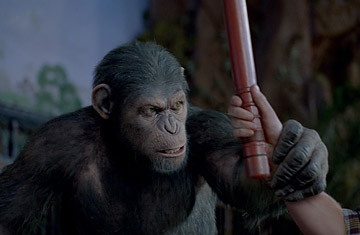
20th Century Fox
The new film The Rise of the Planet of the Apes—a title with way too many prepositions—asks us to accept an absurd premise: James Franco as a genius neuroscientist. Oh, and it also expects us to accept the possibility that apes could become super-smart, enabling them to overthrow humanity as the dominant species on the planet, leading to future where Charlton Heston will do this:
[youtube=http://www.youtube.com/watch?v=i-6L_hT3QtQ]
Now, I’m not the first enterprising writer exploring the science of Planet of the Apes in an attempt to goose page views. In a nice piece over at the Atlantic, Betsy Morais notes that there’s only a 1.2% genetic difference between humans and chimps—indeed, the evolutionary biologist Jared Diamond likes to call humans the “third chimpanzee“. Morais writes that scientists have had some success working on genetic techniques for cognitive improvement—albeit nothing quite as dramatic as the drugs in the film that turn lead chimp Caesar into a simian Spartacus:
More from TIME: Rise of the Planet of the Apes: Chimpan-tastic!
There’s some eerie validity to the on-screen science. The technique used to treat Alzheimer’s in Rise, for example, has been tried in labs. Scientists can engineer what amounts to a genetic delivery system—a virus sent out to the brain that infects neurons with desired genetic material. Once the transfer is made, those genes can change or improve cognitive functioning.
This has been done experimentally, says Dr. Lary Walker of Emory’s Yerkes National Primate Research Center. But usually on mice; never on apes. And the results aren’t quite as extraordinary (or quick) as those seen in the movie. “The idea that the next day, they’re going to be Einsteins—or that at any point they’re going to be Einsteins—is not going to happen,” he says.
Ok, so, it doesn’t look like we’ll be upgrading the wetware of wild chimps any time soon, so we can breathe easy. (As we all know, our doom is far more likely to come at the hands of murderous artificial intelligence.) But even if apes were able to combine their superior strength and speed—gorillas, for one, are six times stronger than we are—with artificial smarts, they still wouldn’t pose much of an existential threat.
Why? Because—thanks largely to us—there are so few of them. The World Wildlife Fund (WWF) estimates that there are at most 500,000 great apes left living in the wild—about the population of Fresno. (Great apes include gorillas, orangutans, chimpanzees and bonobos.) We’ve whittled down the populations of our simian cousins through deforestation—which destroys their habitat—and through hunting, including for meat. Even infectious disease is a major risk—it’s thought that 25% of the world’s gorilla population has died because of Ebola, a deadly fever that currently poses a much greater threat to apes than it does to us. The nonhuman primates look scary in Rise of the Planet of the Apes, but in reality, our closest cousins are in deep trouble. “The current reality of great ape populations is more of a tragedy than an action thriller,” says Richard Carroll, the head of WWF’s Africa program and a gorilla expert. “If we as humans can’t protect our nearest living relatives, then we’ve failed as a species.”
Photos from TIME: It’s a Madhouse. A Madhouse!
Meanwhile, there are nearly 7 billion humans living on every corner of the planet. It wasn’t always this way. More than 10,000 years ago, before the development of agriculture, there may well have been more apes than humans—and at the time, we may not have looked like a very good evolutionary bet. Now humans utterly dominate the world, leaving less and less room and resources for wild animals. The hot new term for our current geologic era is the Anthropocene, which reflects the fact that human beings—through carbon emissions, resource use and simple numbers—are now the major force on the planet, capable of changing the genome and the climate alike. It’s still a Planet of the Humans—and that’s still bad news for the apes.
More from TIME: The New Age of Extinction
Bryan Walsh is a senior writer at TIME. Find him on Twitter at @bryanrwalsh. You can also continue the discussion on TIME’s Facebook page and on Twitter at @TIME


